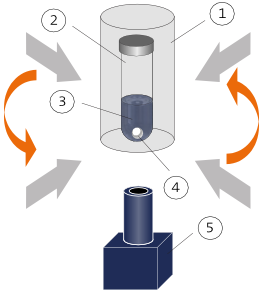Viscometer
Viscometer is an instrument used to measure the viscosity of a fluid. For liquids with viscosities that vary with flow conditions, an instrument called a rheometer is used. Thus, a viscometer can be considered as a special type of rheometer. Viscosity is a fundamental property of fluids which describes the internal resistance offered by a fluid to flow. This property is crucial in characterizing the flow behavior of fluids in various industries such as pharmaceuticals, petrochemicals, and food processing.
Types of Viscometers[edit | edit source]
There are several types of viscometers, each designed for specific types of measurements and fluids. Some of the most common include:
- Capillary Viscometer: Measures viscosity by observing the time it takes for a volume of fluid to flow through a narrow capillary tube under gravity. The Hagen-Poiseuille equation is used to calculate the viscosity.
- Rotational Viscometer: Works by measuring the torque required to rotate an object, such as a spindle, in the fluid at a known speed. The resistance to the movement by the fluid is used to calculate its viscosity.
- Falling Sphere Viscometer: Determines viscosity by measuring the time it takes for a sphere to fall through a fluid in a long vertical tube. The rate of fall is related to the viscosity of the fluid.
- Vibrational Viscometer: Uses the damping of a vibrating element to measure viscosity. The amplitude or frequency of the vibration changes in response to the fluid's viscosity.
- Zahn Cup: A simple device that measures the viscosity of a liquid by recording the time it takes for a fixed volume of liquid to flow out through an orifice at the bottom.
Applications[edit | edit source]
Viscometers are used in a wide range of applications:
- In the food industry, to ensure the quality and consistency of products like sauces, syrups, and dressings.
- In the pharmaceutical industry, to control the viscosity of cough syrups, gels, and ointments, which can affect the absorption of the drug by the body.
- In the petrochemical industry, to measure the viscosity of oil, which is critical for lubrication, drilling, and refining processes.
- In research and development, to understand the flow properties of new materials and products.
Selection Criteria[edit | edit source]
When selecting a viscometer, several factors should be considered:
- Type of fluid: Newtonian (viscosity remains constant regardless of flow conditions) or non-Newtonian (viscosity changes with flow conditions).
- Viscosity range: The instrument must be capable of measuring the expected viscosity range of the fluid.
- Temperature and pressure conditions: Some viscometers can operate under a wide range of temperatures and pressures.
- Accuracy and repeatability: The precision required for the measurement.
Maintenance and Calibration[edit | edit source]
Regular maintenance and calibration are essential for ensuring accurate viscosity measurements. This may involve cleaning the viscometer thoroughly after each use, especially when measuring fluids that can solidify or polymerize. Calibration should be performed using standards with known viscosities to ensure the viscometer's accuracy over time.
| This article is a stub. You can help WikiMD by registering to expand it. |
Search WikiMD
Ad.Tired of being Overweight? Try W8MD's physician weight loss program.
Semaglutide (Ozempic / Wegovy and Tirzepatide (Mounjaro / Zepbound) available.
Advertise on WikiMD
|
WikiMD's Wellness Encyclopedia |
| Let Food Be Thy Medicine Medicine Thy Food - Hippocrates |
Translate this page: - East Asian
中文,
日本,
한국어,
South Asian
हिन्दी,
தமிழ்,
తెలుగు,
Urdu,
ಕನ್ನಡ,
Southeast Asian
Indonesian,
Vietnamese,
Thai,
မြန်မာဘာသာ,
বাংলা
European
español,
Deutsch,
français,
Greek,
português do Brasil,
polski,
română,
русский,
Nederlands,
norsk,
svenska,
suomi,
Italian
Middle Eastern & African
عربى,
Turkish,
Persian,
Hebrew,
Afrikaans,
isiZulu,
Kiswahili,
Other
Bulgarian,
Hungarian,
Czech,
Swedish,
മലയാളം,
मराठी,
ਪੰਜਾਬੀ,
ગુજરાતી,
Portuguese,
Ukrainian
Medical Disclaimer: WikiMD is not a substitute for professional medical advice. The information on WikiMD is provided as an information resource only, may be incorrect, outdated or misleading, and is not to be used or relied on for any diagnostic or treatment purposes. Please consult your health care provider before making any healthcare decisions or for guidance about a specific medical condition. WikiMD expressly disclaims responsibility, and shall have no liability, for any damages, loss, injury, or liability whatsoever suffered as a result of your reliance on the information contained in this site. By visiting this site you agree to the foregoing terms and conditions, which may from time to time be changed or supplemented by WikiMD. If you do not agree to the foregoing terms and conditions, you should not enter or use this site. See full disclaimer.
Credits:Most images are courtesy of Wikimedia commons, and templates, categories Wikipedia, licensed under CC BY SA or similar.
Contributors: Prab R. Tumpati, MD





